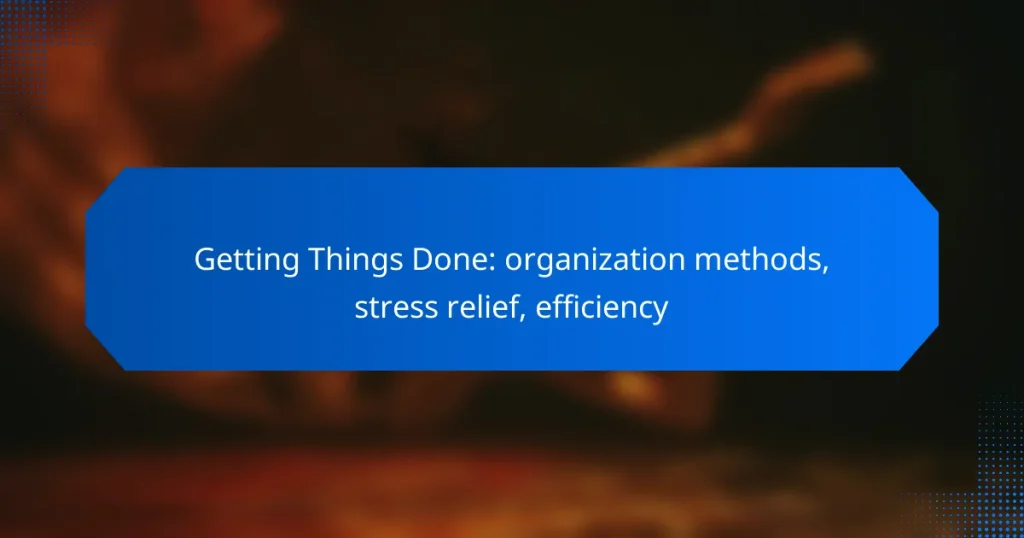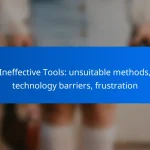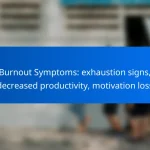Getting Things Done is a powerful approach to organization that emphasizes structured methods for managing tasks and time effectively. By adopting these techniques, individuals can significantly reduce stress, prioritize their responsibilities, and enhance overall productivity, leading to a more efficient and balanced lifestyle.

How can organization methods improve efficiency?
Organization methods enhance efficiency by providing structured approaches to managing tasks and time. By implementing these techniques, individuals can reduce stress, prioritize effectively, and achieve more in less time.
Time blocking
Time blocking involves scheduling specific blocks of time for different tasks or activities throughout the day. This method helps to minimize distractions and maintain focus, as you dedicate uninterrupted time to each task.
To implement time blocking, start by identifying your most important tasks and estimate how long each will take. Create a daily or weekly schedule that allocates time slots for these tasks, ensuring to include breaks to recharge.
Task prioritization
Task prioritization is the process of ranking tasks based on their importance and urgency. By focusing on high-priority tasks first, you can ensure that your efforts yield the greatest impact.
A common method for prioritization is the Eisenhower Matrix, which categorizes tasks into four quadrants: urgent and important, important but not urgent, urgent but not important, and neither urgent nor important. This helps clarify where to direct your energy.
Digital tools like Trello
Digital tools like Trello facilitate organization by allowing users to create boards, lists, and cards to manage tasks visually. These platforms help track progress, set deadlines, and collaborate with others, enhancing overall efficiency.
To maximize the benefits of Trello, create boards for different projects and use labels to categorize tasks. Regularly update the status of tasks to maintain visibility and accountability.
Bullet journaling
Bullet journaling is a customizable organization method that combines a planner, diary, and to-do list. It allows users to track tasks, events, and goals in a creative and personal way.
Start by setting up a key for symbols that represent tasks, events, and notes. Use monthly and daily logs to plan your time, and include habit trackers to monitor progress on personal goals.
Decluttering techniques
Decluttering techniques focus on reducing physical and digital clutter to improve focus and efficiency. A tidy environment can lead to clearer thinking and increased productivity.
Consider the “one in, one out” rule: for every new item you bring into your space, remove one existing item. Regularly assess your belongings and digital files, keeping only what is necessary or brings you joy.
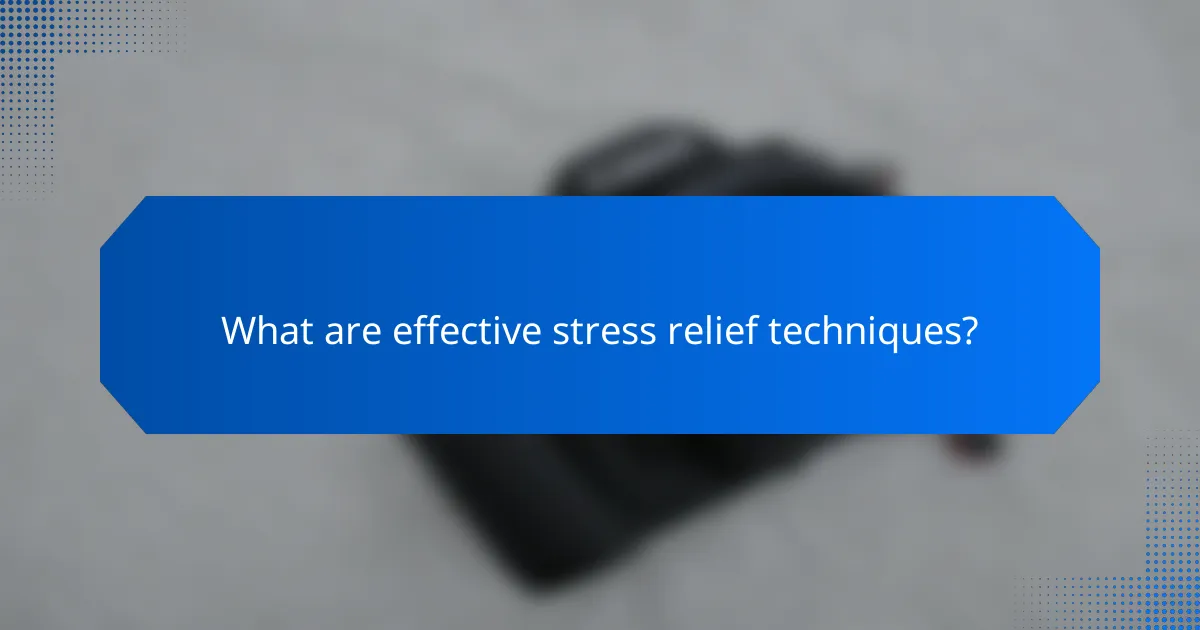
What are effective stress relief techniques?
Effective stress relief techniques help individuals manage anxiety and improve overall well-being. These methods can enhance focus, promote relaxation, and contribute to a healthier lifestyle.
Meditation practices
Meditation involves focusing the mind to achieve a state of calm and clarity. Techniques can vary, but common practices include guided meditation, transcendental meditation, and mindfulness meditation. Beginners might start with just a few minutes daily, gradually increasing to 20-30 minutes as they become more comfortable.
To meditate effectively, find a quiet space, sit comfortably, and concentrate on your breath or a specific mantra. Avoid distractions and aim for consistency, ideally practicing at the same time each day.
Mindfulness exercises
Mindfulness exercises encourage individuals to stay present and fully engage with their current experiences. Simple techniques include mindful eating, where you focus on the taste and texture of your food, or mindful walking, which involves paying attention to each step and the sensations in your body.
Practicing mindfulness can reduce stress by helping you detach from racing thoughts and worries. Start with short sessions of 5-10 minutes, gradually extending the duration as you become more adept at maintaining focus.
Physical activities like yoga
Yoga combines physical postures, breathing exercises, and meditation to promote relaxation and reduce stress. Various styles, such as Hatha, Vinyasa, or Yin yoga, cater to different preferences and fitness levels. Regular practice can enhance flexibility, strength, and mental clarity.
To get started, consider joining a local class or following online tutorials. Aim for at least one session per week, gradually increasing frequency to experience the full benefits of yoga on stress relief.
Breathing techniques
Breathing techniques are simple yet powerful tools for managing stress. Methods like diaphragmatic breathing, box breathing, or the 4-7-8 technique can help calm the nervous system and reduce anxiety levels. These techniques can be practiced anywhere and take only a few minutes.
For example, in the 4-7-8 technique, inhale through your nose for 4 seconds, hold your breath for 7 seconds, and exhale through your mouth for 8 seconds. Repeat this cycle several times to promote relaxation and focus.

How do productivity systems enhance workflow?
Productivity systems enhance workflow by providing structured methods to manage tasks, prioritize responsibilities, and reduce stress. These systems help individuals streamline their processes, leading to improved efficiency and better time management.
Getting Things Done (GTD) method
The Getting Things Done (GTD) method focuses on capturing all tasks and commitments in a reliable system, allowing you to clear your mind and prioritize effectively. It involves five key steps: capturing, clarifying, organizing, reflecting, and engaging. By regularly reviewing your tasks, you can maintain focus and ensure nothing is overlooked.
To implement GTD, start by writing down everything you need to do, then categorize tasks into actionable items, projects, and reference materials. A common pitfall is failing to review your lists regularly, which can lead to overwhelm and decreased productivity.
Pomodoro Technique
The Pomodoro Technique enhances focus and efficiency by breaking work into short, timed intervals called “Pomodoros,” typically lasting 25 minutes, followed by a short break. This method helps maintain concentration and combats fatigue by encouraging regular pauses. After completing four Pomodoros, take a longer break of 15-30 minutes.
To apply this technique, use a timer to track your work intervals and breaks. Avoid distractions during each Pomodoro, and consider using tools like apps or physical timers to keep you accountable. A common mistake is underestimating the importance of breaks, which are crucial for sustaining energy and productivity.
Kanban system
The Kanban system is a visual workflow management method that helps you visualize tasks and their progress through various stages. It uses a board divided into columns representing different phases, such as “To Do,” “In Progress,” and “Done.” This approach allows for real-time tracking of tasks and helps identify bottlenecks in the workflow.
To implement Kanban, create a board using sticky notes or digital tools, and limit the number of tasks in progress to maintain focus. Regularly review and adjust your workflow based on performance and feedback. A common challenge is overloading the board with tasks, which can lead to decreased efficiency and overwhelm.
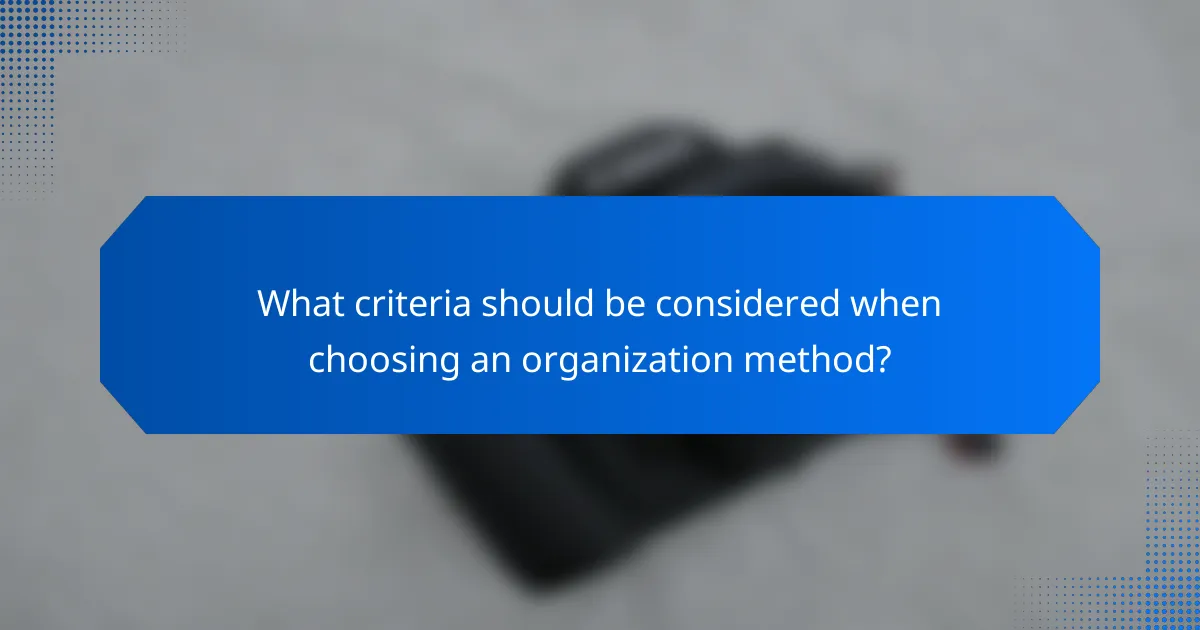
What criteria should be considered when choosing an organization method?
When selecting an organization method, consider your personal work style, the types of tasks you handle, and your available time. Each of these factors influences how effectively a method can enhance your productivity and reduce stress.
Personal work style
Your personal work style significantly impacts the effectiveness of an organization method. Some individuals thrive in structured environments with detailed plans, while others prefer flexibility and spontaneity. Assess whether you are more analytical or creative, as this can guide you towards methods that align with your natural tendencies.
For example, if you enjoy visual aids, methods like mind mapping or Kanban boards might suit you. Conversely, if you prefer lists and schedules, traditional to-do lists or digital task managers could be more effective.
Type of tasks
The nature of your tasks plays a crucial role in determining the best organization method. Tasks can vary widely, from simple daily chores to complex projects requiring multiple steps. Identify whether your tasks are repetitive, project-based, or require collaboration, as this will help you choose a suitable method.
For instance, if you frequently manage projects with deadlines, using project management software like Trello or Asana can streamline your workflow. On the other hand, if your tasks are mostly routine, a straightforward checklist may suffice.
Time availability
Your available time for organization directly affects which methods you can realistically implement. If you have limited time, opt for simpler methods that require minimal setup and maintenance. Conversely, if you can dedicate more time, you might explore more comprehensive systems that offer greater depth.
A good rule of thumb is to spend no more than 10-15% of your work time on organizing tasks. If you find yourself spending excessive time on organization, reevaluate your method to ensure it aligns with your time constraints and productivity goals.
